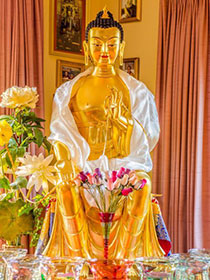- Home
- FPMT Homepage
Foundation for the Preservation of the Mahayana Tradition
The FPMT is an organization devoted to preserving and spreading Mahayana Buddhism worldwide by creating opportunities to listen, reflect, meditate, practice and actualize the unmistaken teachings of the Buddha and based on that experience spreading the Dharma to sentient beings. We provide integrated education through which people’s minds and hearts can be transformed into their highest potential for the benefit of others, inspired by an attitude of universal responsibility and service. We are committed to creating harmonious environments and helping all beings develop their full potential of infinite wisdom and compassion. Our organization is based on the Buddhist tradition of Lama Tsongkhapa of Tibet as taught to us by our founders Lama Thubten Yeshe and Lama Thubten Zopa Rinpoche.
- Willkommen
Die Stiftung zur Erhaltung der Mahayana Tradition (FPMT) ist eine Organisation, die sich weltweit für die Erhaltung und Verbreitung des Mahayana-Buddhismus einsetzt, indem sie Möglichkeiten schafft, den makellosen Lehren des Buddha zuzuhören, über sie zur reflektieren und zu meditieren und auf der Grundlage dieser Erfahrung das Dharma unter den Lebewesen zu verbreiten.
Wir bieten integrierte Schulungswege an, durch denen der Geist und das Herz der Menschen in ihr höchstes Potential verwandelt werden zum Wohl der anderen – inspiriert durch eine Haltung der universellen Verantwortung und dem Wunsch zu dienen. Wir haben uns verpflichtet, harmonische Umgebungen zu schaffen und allen Wesen zu helfen, ihr volles Potenzial unendlicher Weisheit und grenzenlosen Mitgefühls zu verwirklichen.
Unsere Organisation basiert auf der buddhistischen Tradition von Lama Tsongkhapa von Tibet, so wie sie uns von unseren Gründern Lama Thubten Yeshe und Lama Thubten Zopa Rinpoche gelehrt wird.
- Bienvenidos
La Fundación para la preservación de la tradición Mahayana (FPMT) es una organización que se dedica a preservar y difundir el budismo Mahayana en todo el mundo, creando oportunidades para escuchar, reflexionar, meditar, practicar y actualizar las enseñanzas inconfundibles de Buda y en base a esa experiencia difundir el Dharma a los seres.
Proporcionamos una educación integrada a través de la cual las mentes y los corazones de las personas se pueden transformar en su mayor potencial para el beneficio de los demás, inspirados por una actitud de responsabilidad y servicio universales. Estamos comprometidos a crear ambientes armoniosos y ayudar a todos los seres a desarrollar todo su potencial de infinita sabiduría y compasión.
Nuestra organización se basa en la tradición budista de Lama Tsongkhapa del Tíbet como nos lo enseñaron nuestros fundadores Lama Thubten Yeshe y Lama Zopa Rinpoche.
A continuación puede ver una lista de los centros y sus páginas web en su lengua preferida.
- Bienvenue
L’organisation de la FPMT a pour vocation la préservation et la diffusion du bouddhisme du mahayana dans le monde entier. Elle offre l’opportunité d’écouter, de réfléchir, de méditer, de pratiquer et de réaliser les enseignements excellents du Bouddha, pour ensuite transmettre le Dharma à tous les êtres. Nous proposons une formation intégrée grâce à laquelle le cœur et l’esprit de chacun peuvent accomplir leur potentiel le plus élevé pour le bien d’autrui, inspirés par le sens du service et une responsabilité universelle. Nous nous engageons à créer un environnement harmonieux et à aider tous les êtres à épanouir leur potentiel illimité de compassion et de sagesse. Notre organisation s’appuie sur la tradition guéloukpa de Lama Tsongkhapa du Tibet, telle qu’elle a été enseignée par nos fondateurs Lama Thoubtèn Yéshé et Lama Zopa Rinpoché.
Visitez le site de notre Editions Mahayana pour les traductions, conseils et nouvelles du Bureau international en français.
Voici une liste de centres et de leurs sites dans votre langue préférée
- Benvenuto
L’FPMT è un organizzazione il cui scopo è preservare e diffondere il Buddhismo Mahayana nel mondo, creando occasioni di ascolto, riflessione, meditazione e pratica dei perfetti insegnamenti del Buddha, al fine di attualizzare e diffondere il Dharma fra tutti gli esseri senzienti.
Offriamo un’educazione integrata, che può trasformare la mente e i cuori delle persone nel loro massimo potenziale, per il beneficio di tutti gli esseri, ispirati da un’attitudine di responsabilità universale e di servizio.
Il nostro obiettivo è quello di creare contesti armoniosi e aiutare tutti gli esseri a sviluppare in modo completo le proprie potenzialità di infinita saggezza e compassione.
La nostra organizzazione si basa sulla tradizione buddhista di Lama Tsongkhapa del Tibet, così come ci è stata insegnata dai nostri fondatori Lama Thubten Yeshe e Lama Zopa Rinpoche.
Di seguito potete trovare un elenco dei centri e dei loro siti nella lingua da voi prescelta.
- 欢迎 / 歡迎
简体中文
“护持大乘法脉基金会”( 英文简称:FPMT。全名:Foundation for the Preservation of the Mahayana Tradition) 是一个致力于护持和弘扬大乘佛法的国际佛教组织。我们提供听闻,思维,禅修,修行和实证佛陀无误教法的机会,以便让一切众生都能够享受佛法的指引和滋润。
我们全力创造和谐融洽的环境, 为人们提供解行并重的完整佛法教育,以便启发内在的环宇悲心及责任心,并开发内心所蕴藏的巨大潜能 — 无限的智慧与悲心 — 以便利益和服务一切有情。
FPMT的创办人是图腾耶喜喇嘛和喇嘛梭巴仁波切。我们所修习的是由两位上师所教导的,西藏喀巴大师的佛法传承。
繁體中文
護持大乘法脈基金會”( 英文簡稱:FPMT。全名:Found
ation for the Preservation of the Mahayana Tradition ) 是一個致力於護持和弘揚大乘佛法的國際佛教組織。我們提供聽聞, 思維,禪修,修行和實證佛陀無誤教法的機會,以便讓一切眾生都能 夠享受佛法的指引和滋潤。 我們全力創造和諧融洽的環境,
為人們提供解行並重的完整佛法教育,以便啟發內在的環宇悲心及責 任心,並開發內心所蘊藏的巨大潛能 — 無限的智慧與悲心 – – 以便利益和服務一切有情。 FPMT的創辦人是圖騰耶喜喇嘛和喇嘛梭巴仁波切。
我們所修習的是由兩位上師所教導的,西藏喀巴大師的佛法傳承。 察看道场信息:
- FPMT Homepage
- News/Media
-
- Study & Practice
-
-
- About FPMT Education Services
- Latest News
- Programs
- New to Buddhism?
- Buddhist Mind Science: Activating Your Potential
- Heart Advice for Death and Dying
- Discovering Buddhism
- Living in the Path
- Exploring Buddhism
- FPMT Basic Program
- FPMT Masters Program
- FPMT In-Depth Meditation Training
- Maitripa College
- Lotsawa Rinchen Zangpo Translator Program
- Universal Education for Compassion & Wisdom
- Online Learning Center
-
- Prayers & Practice Materials
- Overview of Prayers & Practices
- Full Catalogue of Prayers & Practice Materials
- Explore Popular Topics
- Benefiting Animals
- Chenrezig Resources
- Death & Dying Resources
- Lama Chopa (Guru Puja)
- Lama Zopa Rinpoche: Compendium of Precious Instructions
- Lama Zopa Rinpoche: Life Practice Advice
- Lama Zopa Rinpoche Practice Series
- Lamrim Resources
- Mantras
- Prayer Book Updates
- Purification Practices
- Sutras
- Thought Transformation (Lojong)
- Audio Materials
- Dharma Dates - Tibetan Calendar
- Translation Services
- Publishing Services
- Ways to Offer Support
- Prayers & Practice Materials
-
- Teachings and Advice
- Find Teachings and Advice
- Lama Zopa Rinpoche Advice Page
- Lama Zopa Rinpoche: Compendium of Precious Instructions
- Lama Zopa Rinpoche Video Teachings
- ༧སྐྱབས་རྗེ་བཟོད་པ་རིན་པོ་ཆེ་མཆོག་ནས་སྩལ་བའི་བཀའ་སློབ་བརྙན་འཕྲིན།
- Podcasts
- Lama Yeshe Wisdom Archive
- Buddhism FAQ
- Dharma for Young People
- Resources on Holy Objects
- Teachings and Advice
-
-
*If a menu item has a submenu clicking once will expand the menu clicking twice will open the page.
-
-
- Centers
-
- Teachers
-
- Projects
-
-
-
-
*If a menu item has a submenu clicking once will expand the menu clicking twice will open the page.
-
-
- FPMT
-
-
-
-
-
Many times we mix our compassion with attachment. We begin with compassion, but after some time, attachment mixes in and then it becomes an attachment trip.
Lama Thubten Yeshe
-
-
-
- Shop
-
-
-
The Foundation Store is FPMT’s online shop and features a vast selection of Buddhist study and practice materials written or recommended by our lineage gurus. These items include homestudy programs, prayers and practices in PDF or eBook format, materials for children, and other resources to support practitioners.
Items displayed in the shop are made available for Dharma practice and educational purposes, and never for the purpose of profiting from their sale. Please read FPMT Foundation Store Policy Regarding Dharma Items for more information.
-
-
Lama Zopa Rinpoche News and Advice
25
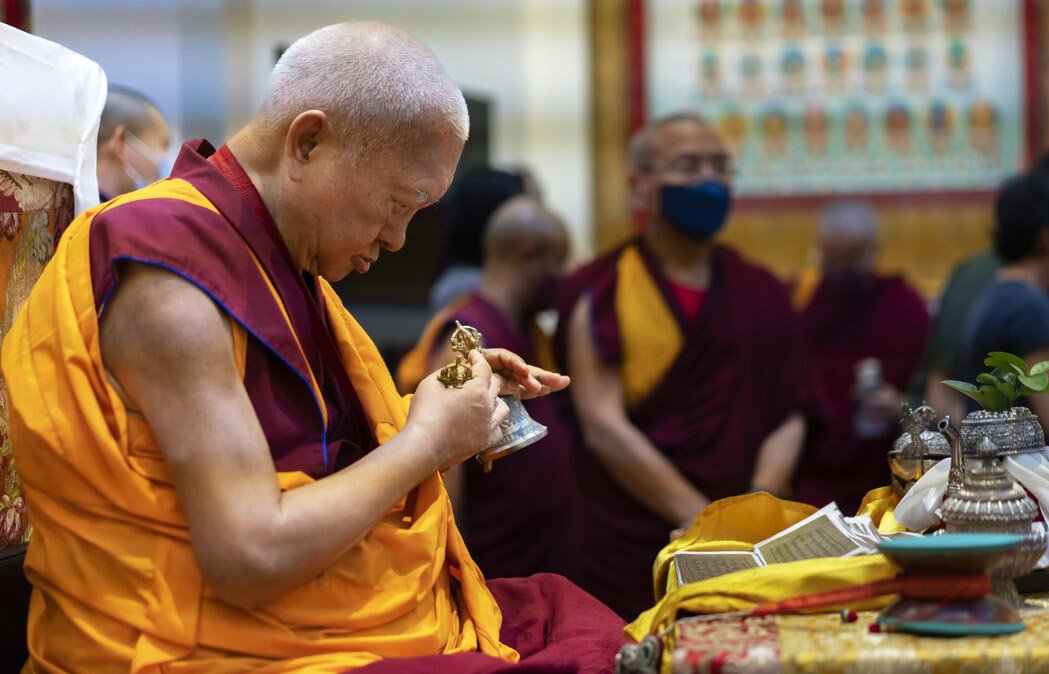
Lama Zopa Rinpoche offering concluding prayers after initiations at Amitabha Buddhist Centre, Singapore, August 2022. Photo by Ven. Lobsang Sherab.
Lama Zopa Rinpoche offered this unrestricted video teaching on August 27, 2022 from Amitabha Buddhist Centre, Singapore, before giving a Heruka Body Mandala initiation. Here’s a summary of Rinpoche’s teaching:
Rinpoche offers the oral transmission of Kachen Yeshe Gyaltshen’s Lojong Chenmo starting at 1:33 in the video and then offers commentary on Advice to Correctly Follow the Virtuous Friend with Thought and Action: The Nine Attitudes of Guru Devotion by mahasiddha Tsogdrug Rangdrol starting at 17:32.
Rinpoche discusses these verses from Shantideva’s Bodhicharyavatara (v. 3.29ab-3.32ab) starting at 1:31:49:
Bodhicitta is the supreme nectar
Destroying the Lord of Death of transmigratory beings.
It is also the unceasing treasure
Eliminating the poverty of transmigratory beings.
Bodhicitta is the best medicine
Healing all the diseases of transmigratory beings.
It is a tree of rest for transmigratory beings
Wandering and exhausted on the samsaric path.
It is like the rising moon of the mind
Eliminating the suffering of the disturbing thoughts of transmigratory beings.
Bodhicitta is the great sun eliminating
The defective view of the ignorance of transmigratory beings.
Bodhicitta is the essence of butter
From churning the milk of the holy Dharma.
It is very rare to generate bodhicitta, Rinpoche reminds us, but in this life we are fortunate to be able to do so. It is important to prepare for death and to write down how one wants to die and what practices one wishes to do at this time. This is the most critical point of life, and we don’t think of it, we ignore it all the time. However, as a human being we have an incredible opportunity to plan for when we are dying. Bodhicitta is the best nectar, so dying with bodhicitta is the best death.
We invite you to go deeper into the topics presented here, plus many others, by watching Rinpoche’s video below.
Watch Lama Zopa Rinpoche’s teaching “To Practice Tantra You Need Guru Devotion and Bodhicitta”:
This summary of Lama Zopa Rinpoche’s teaching is by Carina Rumrill, based on the live transcript by Ven. Joan Nicell and checked by Laura Haughey, with editorial input and additions by Justin Jenkins. This summary is meant to highlight key topics presented by Rinpoche in the recorded video and is not intended to serve as a full representation of Rinpoche’s teaching, which is best received through watching the video and/or reading the full transcript.
Lama Zopa Rinpoche is the spiritual director of the Foundation for the Preservation of Mahayana Tradition (FPMT), a Tibetan Buddhist organization dedicated to the transmission of the Mahayana Buddhist tradition and values worldwide through teaching, meditation and community service.
- Tagged: advice from lama zopa rinpoche, video
24
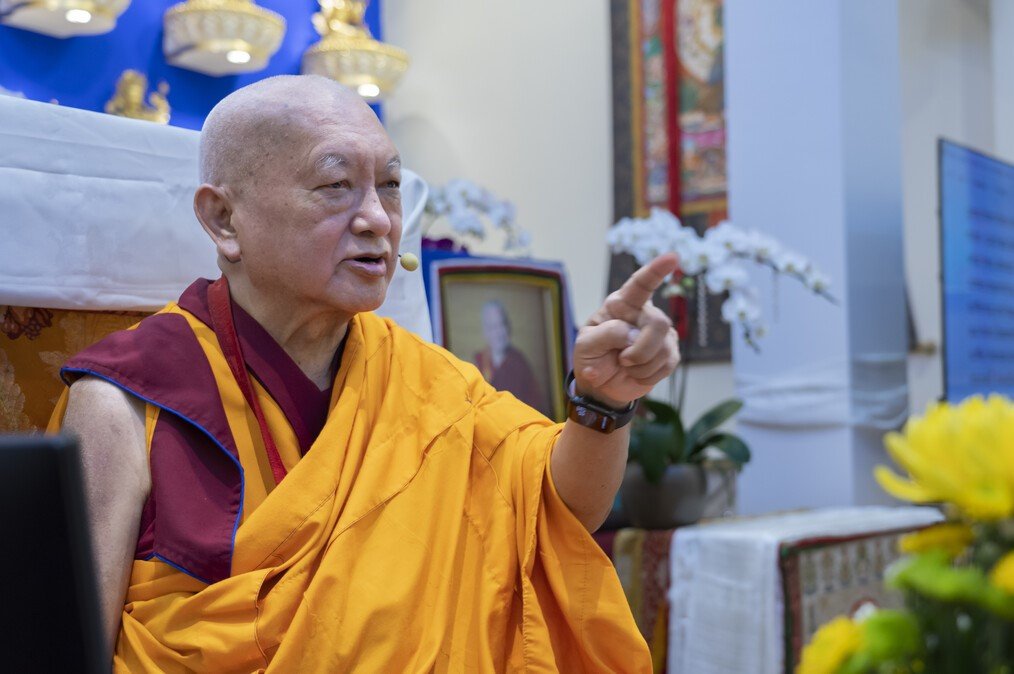
Lama Zopa Rinpoche offering thought transformation teachings at Amitabha Buddhist Centre, Singapore, September 14, 2022. Photo by Ven. Lobsang Sherab.
Lama Zopa Rinpoche continued his video teachings on thought transformation from Amitabha Buddhist Centre, Singapore in August and September, 2022. Here is a summary of the most recent teaching recorded on September 14, 2022:
By not harming others, we are creating the cause for peace in the future, Rinpoche explains. If we fight those who harm us in this life, it creates the cause to fight them again in future lives. This can go on for eons with no peace. Those who win create the cause to lose in the future, and those who lose create the case to win in the future. This is repeated on and on endlessly, a cycle of negative karma and no harmony. If we follow the path of not harming, not fighting, this is the way to create peace in the future.
Rinpoche discusses The Heart Advice of Kadam Scriptures: A Good Vase of Nectar (v. 37):
Whatever happiness and suffering there is in samsara,
All of it comes from your karma.
Therefore, at all times examine your three doors,
And make effort to abandon negative karma and practice virtue.
All the time we should examine our body, speech and mind, all three doors. We should abandon negative karma which is the cause of suffering, and practice Dharma to achieve enlightenment.
When we practice Dharma we are taking care of ourselves, Rinpoche explains. When we don’t practice Dharma, we are not taking care of ourselves, we are using ourselves like garbage, like toilet paper. When we practice Dharma we protect ourselves, we are being a friend to ourselves.
Tonglen is the main practice, Rinpoche urges. When we transform bad conditions into the path to enlightenment, negative experiences are transformed into fortune, into virtue. We can rejoice when we have suffering by thinking of the benefits. Kharag Gomchung said in Seventy-Two Exhortations (v. 7):
Bad conditions are your virtuous friend.
Obstacles persuade you to engage in virtue.
Suffering is a broom that sweeps negative karma away.
Don’t look at suffering as a mistake.
We can begin by transforming small sufferings into the path to enlightenment. By doing this, we are training the mind to be able to transform great problems as well. Since all suffering comes from the self-cherishing thought, when undesirable things arise, we can give it back to the self-cherishing thought, which completely destroys it and we can actually enjoy whatever pain or unpleasant situation arises.
From Lama Chopa (LC 91):
This chronic disease of cherishing myself
Is the cause giving rise to my unsought suffering.
Perceiving this, I seek your blessings to blame, begrudge,
And destroy the monstrous demon of selfishness.
Rinpoche leads a tonglen meditation starting at 2:35:27 in the video.
Rinpoche also offered the Refuge ceremony and some advice regarding taking refuge, starting at 49:56 in the video.
We invite you to go deeper into the topics presented here, plus many others, by watching Rinpoche’s video below and reading the full transcript of Rinpoche’s teaching.
Watch Lama Zopa Rinpoche’s teaching “Tonglen is the Main Practice”:
- Read the transcript of Rinpoche’s teaching.
- Find Rinpoche’s Teachings on Thought Transformation translated into various languages.
- Dedication verses
Summary of Lama Zopa Rinpoche’s teaching by Carina Rumrill based on the transcript by Ven. Joan Nicell with editorial input and additions by Justin Jenkins. This summary is meant to highlight key topics presented by Rinpoche in the recorded video and is not intended to serve as a full representation of Rinpoche’s teaching, which is best received through watching the video and/or reading the full transcript.
Watch more from the video series Lama Zopa Rinpoche’s Teachings on Thought Transformation and find links to videos in transcripts, MP3s, additional practice advice, and more:
https://fpmt.org/fpmt/announcements/resources-for-coronavirus-pandemic/advice-from-lama-zopa-rinpoche-for-coronavirus/
You can listen to this teaching on our full-length-teachings podcast as well:
https://fpmt.org/media/podcasts/
Lama Zopa Rinpoche is the spiritual director of the Foundation for the Preservation of Mahayana Tradition (FPMT), a Tibetan Buddhist organization dedicated to the transmission of the Mahayana Buddhist tradition and values worldwide through teaching, meditation and community service.
- Tagged: advice from lama zopa rinpoche, coronavirus, lama zopa rinpoche thought transformation video teaching, video
20

Lama Zopa Rinpoche visiting students in Singapore, July 2022. Photo by Sengsiong Photography .
Since our last update, Lama Zopa Rinpoche offered very precious teachings at Amitabha Buddhist Centre, Singapore, in August and September. Some of these teachings have been part of the ongoing thought transformation series, and some were various talks given on particular occasions to specific groups. Following his visit in Singapore, Rinpoche traveled to India to receive teachings from Togden Rinpoche and Jhado Rinpoche at Tashi Lhunpo Monastery in Bylakuppe, India. In addition, Rinpoche engaged in a variety of auspicious activities, benefiting and blessing others with Rinpoche’s tireless compassionate action.
We invite you to read more about some of these activities below and to join us in rejoicing about how Rinpoche inspires us all to live a full and beneficial life.
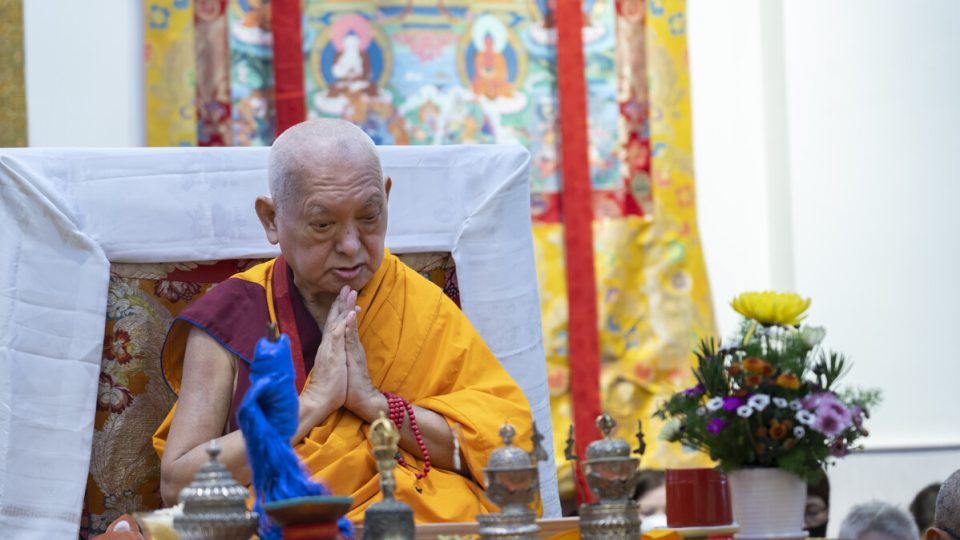
Lama Zopa Rinpoche leading a Most Secret Hayagriva tsog kong puja at Amitabha Buddhist Centre, Singapore, September 4, 2022. Photo by Ven. Lobsang Sherab.
Offering Teachings and Blessings
Rinpoche began teaching at Amitabha Buddhist Centre (ABC) in Singapore in August. While at ABC, Rinpoche offered numerous teachings on thought transformation, recorded as videos 129-137 in the ongoing thought transformation teaching series, which began in the early days of the pandemic in 2020. Other teachings included topics such as: You are So Fortunate to Meet the Lamrim Teachings, With This Human Rebirth You Can Be Happy Day and Night, The Kindness of the Buddha is Limitless Like the Sky, Advice for Generating Peace in the World, and other teachings that we are making available regularly. Rinpoche also offered Heruka Five-deity and Heruka Body Mandala initiations while at ABC and led a Most Secret Hayagriva tsog kong as well as a Lama Chopa puja for Chokhor Duchen (“Wheel-Turning Day”), on August 1. Rinpoche offered a teaching during the puja, titled The Kindness of Buddha is Limitless Like the Sky.
While in Singapore in September, Rinpoche also benefited the beings in the ocean by leading practices for them, as well as blessing many bottles of water over many days and then putting those in the ocean with Namgyalma mantra boards which purifies any being in the water. Rinpoche strongly encouraged this practice to bless those living in water around the world. This is now being done regularly in oceans and lakes in the United States, Singapore, Nepal, and other countries.
In South India, Rinpoche was joined by the Gyudmed Monastery abbot and monks at Rabgayling Tibetan Settlement, Hunsur, on October 16 to consecrate the beautiful forty-two foot stupa that Rinpoche sponsored for elders in the home at the settlement. Rinpoche offered a teaching to the local population on the benefits of reciting mantras, seeing stupas, and circumambulating holy objects.
On October 17, Rinpoche began teaching in Tibetan on lojong and offered advice to Sere Je Drati Khangtsen after paying a visit to the monastery’s newly renovated main office, and these teachings will continue in future years. The next day, October 18, Rinpoche began offering teachings in Tibetan on The Foundation of all Good Qualities by Lama Tsongkhapa at Sera Je Tsawa Khangtsen which will also continue in the future.
You can find Rinpoche’s recent teachings here: https://fpmt.org/media/streaming/teachings-of-lama-zopa-rinpoche/
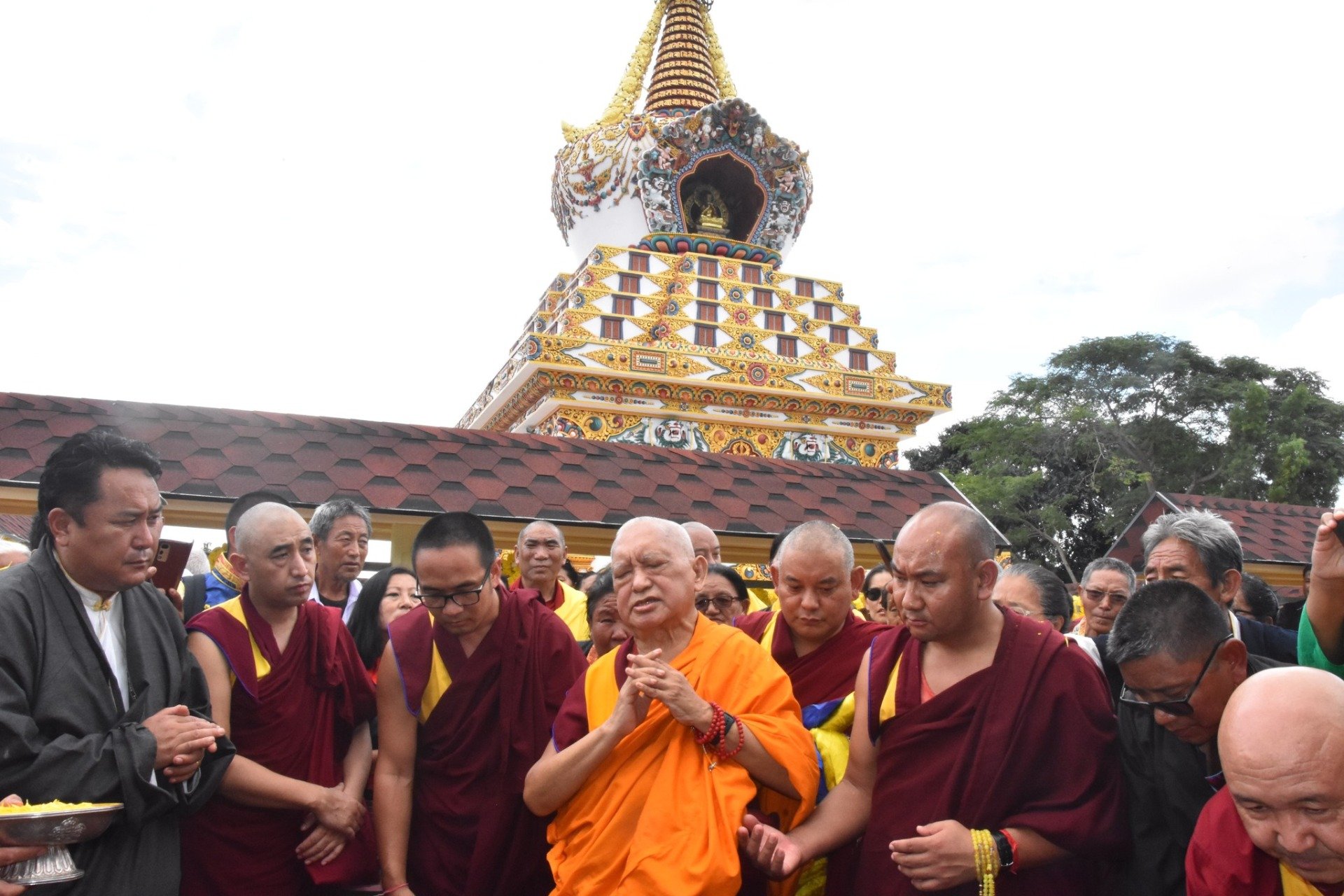
Lama Zopa Rinpoche blessing the beautiful stupa at Rabgayaling Settlement. Photo courtesy of Gyudmed Monastery Facebook page.
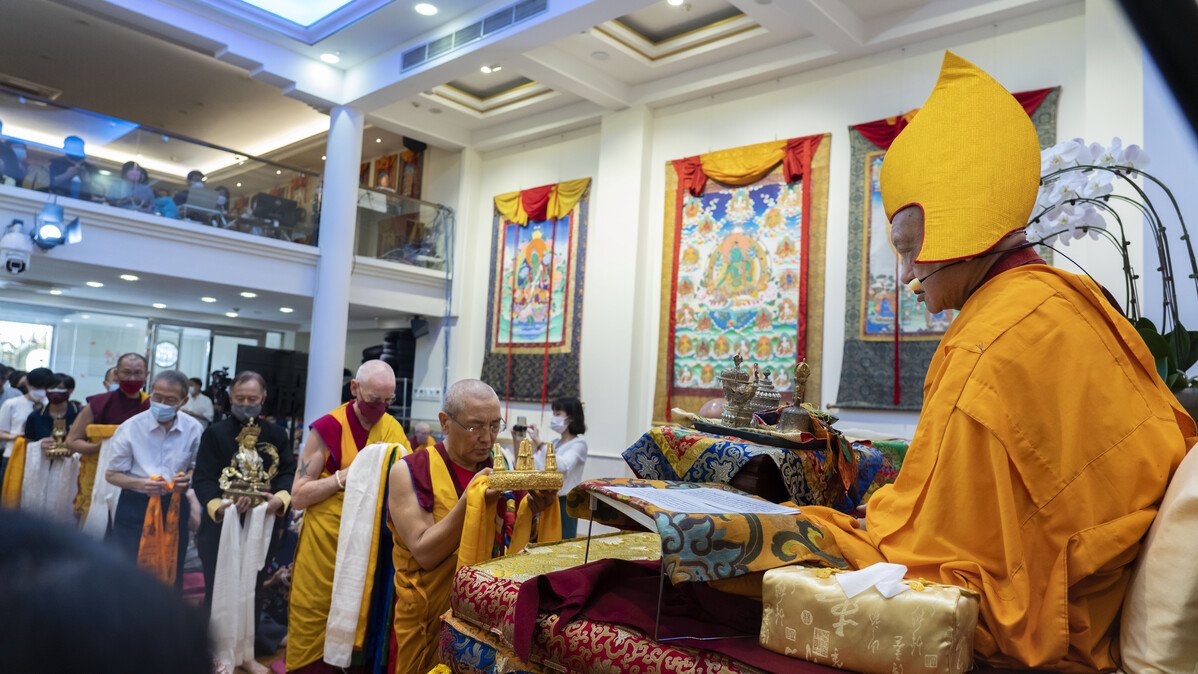
Lama Zopa Rinpoche receiving offering procession during long life puja at Amitabha Buddhist Centre, Singapore, September 11, 2022. Photo by Ven. Lobsang Sherab.
Long Life Pujas
On September 11, a few days before Rinpoche’s departure, ABC offered a beautiful long life puja for Rinpoche in thanks for the precious teachings Rinpoche offered during his three-month stay in Singapore.
On October 14, a long life puja and “Expression of Gratitude” award was offered to Lama Zopa Rinpoche at Sera Je Monastery. This special event was to honor Rinpoche for the many decades of support Rinpoche has shown to the monastery, including the 25+ year accomplishment of the Sera Je Food Fund, which is now a full endowment covering the monastery’s yearly food expenses for over 2,000 Sangha. About this event, Sera Je monk Ven. Tenzin Legtsok, shared:
“This was a rare occasion when literally all of the monks of Sera Je came together from the youngest school boys up to the ex-abbots, the most senior monks from Buxa, all the geshes, tulkus, geshe program students, and monastery staff. Among the eminent lamas in attendance were the two former abbots of Sera Je, Khensur Rinpoche Lobsang Delek and Logoan Tulku Tenzin Choesang, the ex-abbot of Namgyal Monastery, Jhado Rinpoche, the current abbot of Sera Mey Monastery, Geshe Tashi Tsering, the abbot in waiting of Gyume Monastery, Geshe Ngawang Sangye and others. There were also representatives from the local Tibetan government. Everyone was there. Just the presence of so many monks was a powerful and palpable expression of their sincere respect for Rinpoche and their deep gratitude for His support over so many years. Every monk I spoke to was very happy that the monastery had decided to organize this long life puja and award ceremony for Rinpoche. Inside, the prayer hall was filled to overflowing with geshes and senior monks in the late years of the Geshe Studies Program such that the younger monks and school boys all had to sit outside.”
You can read more about this very special long life puja and recognition of Rinpoche’s beneficial activities.
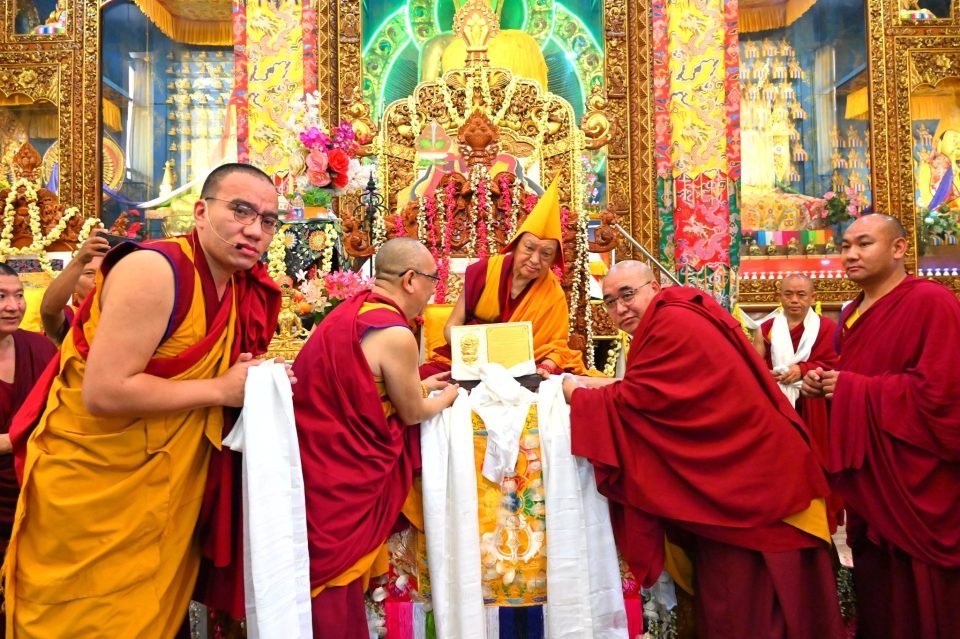
Lama Zopa Rinpoche being presented “Expression of Gratitude” award during long life puja offered by Sera Je Monastery, Bylakuppe, India, October 14, 2022. Photo Courtesy of Sera Je Monastery Facebook page.
Attending Teachings
From Singapore, Lama Zopa Rinpoche flew to India to receive teachings himself, arriving at the Bangalore airport late in the evening, September 19. Rinpoche was received at the airport by eminent Sangha from the various monasteries in South India. These dignitaries included the Abbot of Sera Je Monastic University, Geshe Tashi Tshethar, the Chant Master (Lama Umze) of Gyume Tantric Monastery, Geshe Ngawang Sangye, the Chief Administrator of Sera Je Monastery, Geshe Ngawang Jangchup, and the Secretary and Chief Mentor of Sera Je Drati Khangtsen. They all offered khatas to Rinpoche and requested blessings. Rinpoche spent about an hour at the airport talking with the monastery leaders over tea.
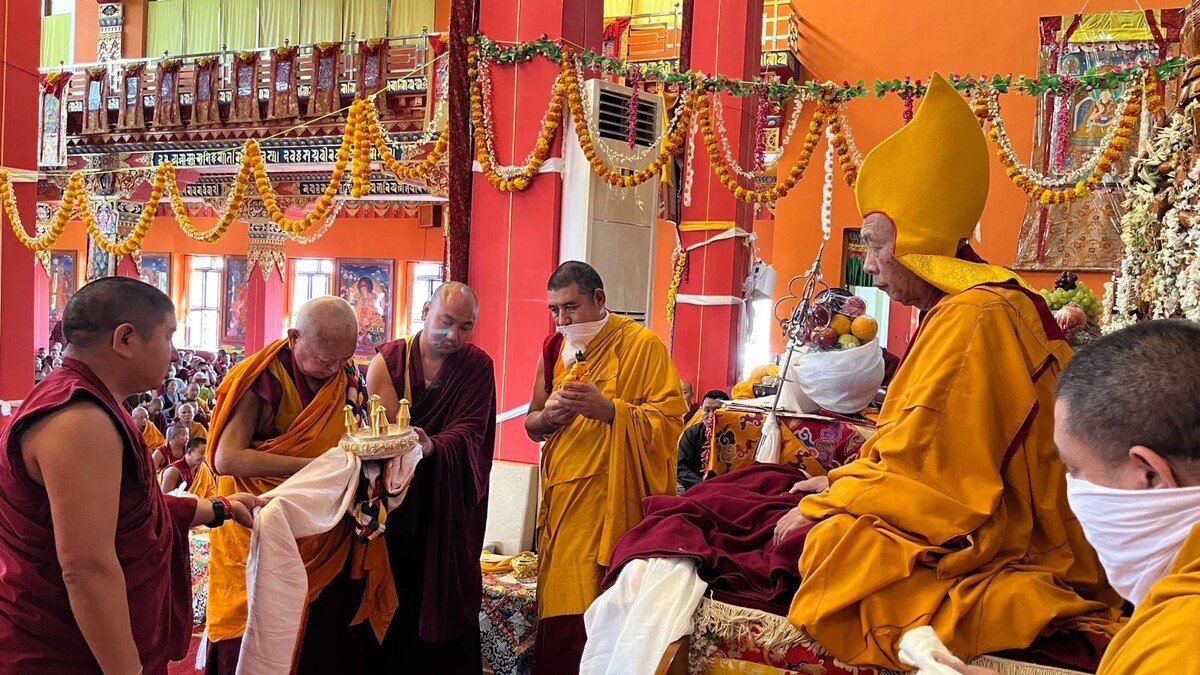
Lama Zopa Rinpoche offering the thanking mandala to Togden Rinpoche at the conclusion of teachings at Tashi Lhunpo Monastery, South India. October 12, 2022.
Beginning on September 22 through October 12, at Tashi Lhunpo Monastery, Bylakuppe, India, Lama Zopa Rinpoche, along with over 1,000 ordained Sangha, including high lamas, received a number of initiations and commentary from Togden Rinpoche. The teaching event started with the Thirteen-Deity Yamantaka, Guhyasamaja, Heruka, and Heruka Body Mandala initiations. Togden Rinpoche then offered the oral transmission and commentary of The Harbor of the Ocean of Great Bliss, a commentary of the creation and completion stages of Heruka practice in the Ghantapa lineage, that had been given by His Holiness Trijang Rinpoche, one of the tutors to His Holiness the Dalai Lama, in 1975. Togden Rinpoche received the teaching at that time directly from H.H. Trijang Rinpoche. Lama Zopa Rinpoche recently sponsored the publication of that commentary in Tibetan.
During the same time in late September, Rinpoche also attended teachings given in the afternoon by Jhado Rinpoche at Tashi Lhunpo on The Three Pith Instructions.
Lama Zopa Rinpoche was very happy to sponsor both of these precious teaching events. This included making offerings every day to the 1,000 Sangha in attendance, offering three meals a day to all, plus offering tea and bread during the teachings. Due to the kindness of two generous benefactors, Rinpoche was able to cover all the costs of sponsorship for these most valuable events.
On October 2, Rinpoche received teachings online from His Holiness the Dalai Lama, on chapter two of Dharmakirti’s Commentary on Valid Cognition, a teaching that was offered by His Holiness at the request of a group of Taiwanese Buddhists.
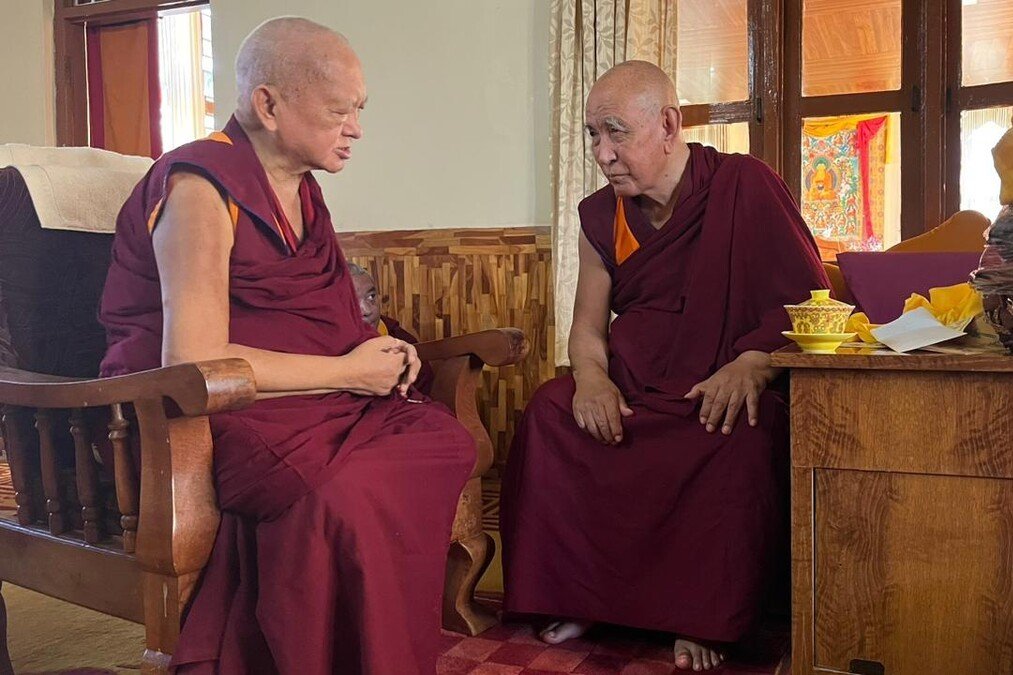
Lama Zopa Rinpoche meeting with the 104th Ganden Tripa, H.E. Lobsang Tenzin Rinpoche, September 21, 2022. Photo by Ven. Lhundrup Topgye.
Meeting with High Lamas and Monastery Leaders
During his trip to South India, Rinpoche met with a number of leaders and high lamas from the great monasteries in the region. On September 21, Rinpoche met with the current throne-holder of the Gelug lineage, His Eminence the 104th Ganden Tripa Lobsang Tenzin Rinpoche. Earlier Rinpoche met with Sera Mey Abbott Khen Rinpoche Geshe Tashi Tsering, the former longtime resident teacher at FPMT-affiliate Jamyang Buddhist Centre in London, England. On September 23, Rinpoche visited with Khenchen Pema Sherab from Namdroling Monastery.
Later that week Rinpoche visited with the abbot and manager of Gyudmed Tantric College. Rinpoche then met with Geshe Drugdra from Gyudmed, a teacher whom Rinpoche has received oral transmissions from recently.
In October, Rinpoche met with the abbott of Tashi Lhunpo Monastery, Khen Rinpoche Tehor Zeekgyab Tulku, and on another occasion, Oser Rinpoche. Rinpoche also had visits with the present reincarnations of three of his teachers, Choden Rinpoche, Domo Geshe Rinpoche, and the current tulku of Ribur Rinpoche.
Please Rejoice
Join us in rejoicing in all of these incredible activities, teachings, important meetings, and opportunities Rinpoche has created to benefit beings continuously and in the most expansive ways possible.
We invite you to see more photos of Rinpoche in our Singapore & India July–September 2022 photo album:
Lama Zopa Rinpoche is the spiritual director of the Foundation for the Preservation of Mahayana Tradition (FPMT), a Tibetan Buddhist organization dedicated to the transmission of the Mahayana Buddhist tradition and values worldwide through teaching, meditation and community service.
- Tagged: essential extracts podcast, kopan monastery, lama zopa rinpoche, lama zopa rinpoche activities, singapore
18
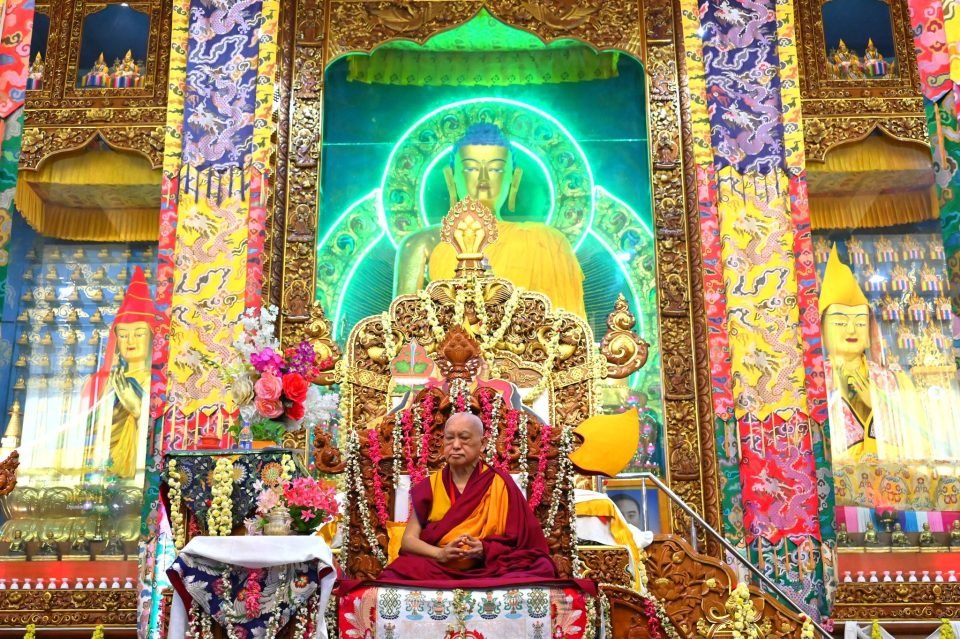
Lama Zopa Rinpoche during the long life puja offered by Sera Je Monastery, Bylakuppe, India, October 14, 2022. Photo Courtesy of Sera Je Monastery Facebook page.
On October 14, a long life puja and “Gratitude Award” was offered to Lama Zopa Rinpoche at Sera Je Monastery. This special event was to honor Rinpoche for the many decades of support Rinpoche has shown to the monastery, including the 25+ year accomplishment of the Sera Je Food Fund, which is now a full endowment covering the monastery’s yearly food expenses for over 2,000 Sangha.
Sera Je monk Ven. Tenzin Legtsok, shares the moving show of support to Rinpoche:
“This was a rare occasion when literally all of the monks of Sera Je came together from the youngest school boys up to the ex-abbots, the most senior monks from Buxa, all the geshes, tulkus, geshe program students, and monastery staff. Among the eminent lamas in attendance were the two former abbots of Sera Je, Khensur Rinpoche Lobsang Delek and Logoan Tulku Tenzin Choesang, the ex-abbot of Namgyal Monastery, Jhado Rinpoche, the current abbot of Sera Mey Monastery, Geshe Tashi Tsering, the abbot in waiting of Gyume Monastery, Geshe Ngawang Sangye and others. There were also representatives from the local Tibetan government. Everyone was there. Just the presence of so many monks was a powerful and palpable expression of their sincere respect for Rinpoche and their deep gratitude for His support over so many years. Every monk I spoke to was very happy that the monastery had decided to organize this long life puja and award ceremony for Rinpoche. Inside, the prayer hall was filled to overflowing with geshes and senior monks in the late years of the Geshe Studies Program such that the younger monks and school boys all had to sit outside.”

Lama Zopa Rinpoche arriving to Sera Je Monastery before the long life puja, Bylakuppe, India, October 14, 2022. Photo Courtesy of Sera Je Monastery Facebook page.
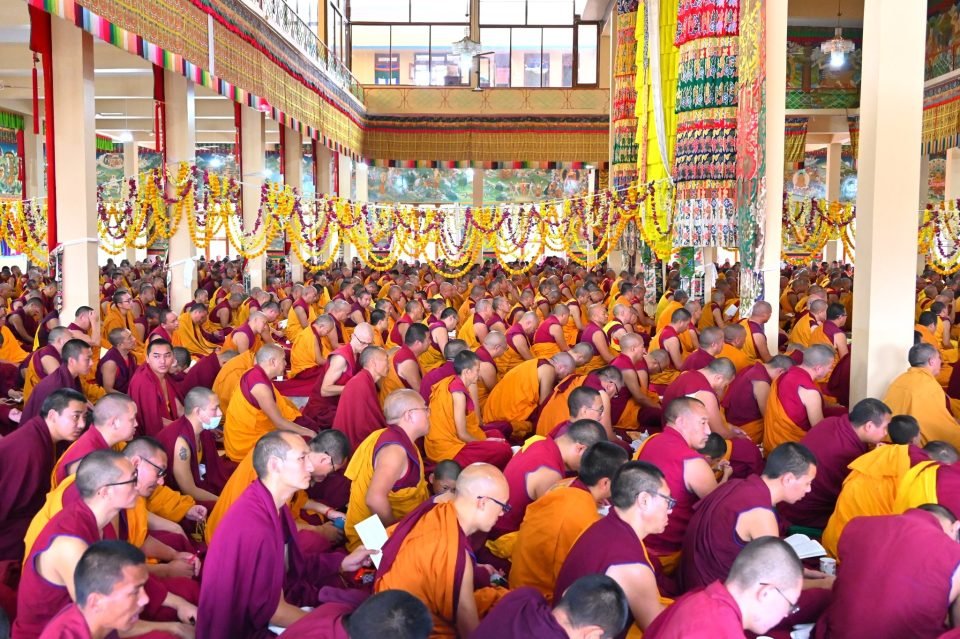
Sangha of Sera Je Monastery offering a long life puja to Lama Zopa Rinpoche, Bylakuppe, India, October 14, 2022. Photo Courtesy of Sera Je Monastery Facebook page.
The proceedings began with an hour of opening prayers, followed by processions of mandala offerings made by leaders of the monastery and each khangtsen (monastic community house), as well as the monastery school, healthcare center, and library. The Sangha of Sera Je then made extensive auspicious offerings, completing with the main mandala offering to Rinpoche coming from Sera Je abbot Geshe Tashi Tsethar. The abbot’s words to Rinpoche are recounted here by Ven. Legtsok:
“He began by recounting how difficult the situation was for the monks before Rinpoche began offering food. Money was extremely scarce and most monks struggled to get enough food to eat. As a result, many came down with illnesses or left. Seeing that this situation was a source of much suffering and a hindrance to the development of the monastic community, Khensur Rinpoche Lobsang Tsering requested Rinpoche to help sponsor food for the monks. That was thirty-one years ago. Since then, Rinpoche has continually provided funding for three meals per day enabling the monastic community to thrive.
“The abbot recounted how, wishing to ensure that the monks were provided with food far into the future Rinpoche endeavored on the monumental task to build up an endowment such that the cost of food would be covered by the interest from this fund. In 2017 FPMT offered this endowment of US$5.3 million. Again and again the abbot said that to express all of Rinpoche’s holy deeds would be impossible and totally beyond him. But to mention a few more he recounted Rinpoche’s support for building the current prayer hall when the old one had been outgrown, Rinpoche’s support over many years for the Sera Je School, for the healthcare center, the library, for the many khangtsens and private house groups, for other monasteries belonging to both the Geluk, Sakya, Nyingma, and Kagyu Traditions, as well as for schools, clinics, homes for the elderly and more in the Tibetan exile community as well as Nepal and India, not to mention building countless holy objects.
“The abbot expressed how this immense work of generosity was not Rinpoche’s alone but has also been the work of Venerable Roger Kunsang, other FPMT International office staff, sponsors, and the hundred-fifty plus FPMT centers, projects, and all the benefactors and students. As the abbot spoke all were silent and one could feel the energy of gratitude build as the monks took to mind all that Rinpoche and FPMT have done for them and countless others. Voicing one kindness after another and looking out at the sea of geshes and monks in their yellow robes that Rinpoche’s generosity has enabled to grow so large, the abbot teared up and had to pause for a few moments to collect himself. So sincere was his deep appreciation.”
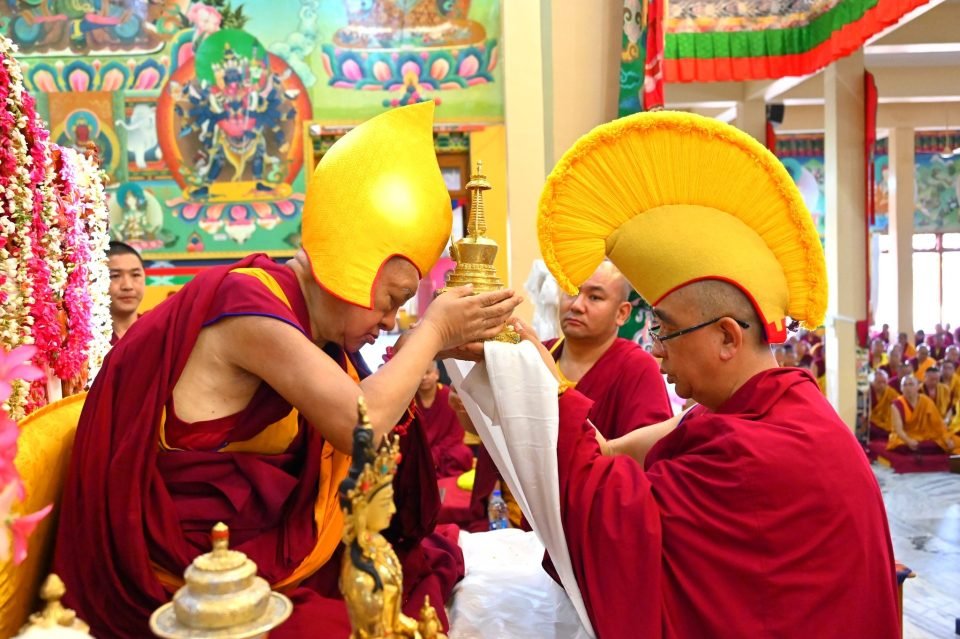
Lama Zopa Rinpoche receiving a stupa during long life puja offered by Sera Je Monstery, Bylakuppe, India, October 14, 2022. Photo courtesy Sera Je Monastery Facebook page.
The long life puja spanned over four hours, at the end of which Lama Zopa Rinpoche offered words of humility and then requested to informally share some advice. Ven. Legtsok summarizes some of Rinpoche’s words:
“The most important thing in studying in the monastery, Rinpoche said, was for it not to remain mere words but that it be accompanied by sincere practice. The essence of practice is to subdue the mind. To transform the mind into Dharma. If we do not subdue our minds and transform our actions into Dharma then the whole thing becomes a waste, another worldly endeavor with no benefit for ourselves or others.”
Rinpoche then offered further advice on methods to subdue the mind. The events concluded with the monastery disciplinarian offering a telling of Lama Zopa Rinpoche’s life story and thanking Rinpoche, Ven. Roger Kunsang, and all the FPMT staff, centers, teachers, students, benefactors, and all the organizers of the event.

Lama Zopa Rinpoche being presented “Expression of Gratitude” award during long life puja offered by Sera Je Monastery, Bylakuppe, India, October 14, 2022. Photo Courtesy of Sera Je Monastery Facebook page.
Awards Presented By the Monastery
The “Expression of Gratitude” award presented to Lama Zopa Rinpoche reads:
In honor of His Eminence Kyabje Lama Zopa Rinpoche’s immense contribution to the preservation and promotion not only within the Buddhist community domain but across the globe, disseminating the wisdom and knowledge of the Buddha Dharma. In particular, Rinpoche has remained the principal patron and benefactor of Sera Je Monastery through significant support to major projects and programs, such as the Assembly Hall, annual All Gelug Institute’s Winter Debate, known as ‘”Jang-Gun-Choe;” annual All Gelug University Board Examinations, and the Sera Je Food Fund since 1991.
This Expression of Gratitude is hereby presented to H.E. Kyabje Lama Zopa Rinpoche, in recognition and profound appreciation of His Infinite kindness and philanthropic support to Sera Je Monastery, and in continuing his numerous spiritual, educational, and social development mission projects and programs.
Ven. Roger Kunsang was also recognized at this ceremony for his decades-long devotion to Lama Zopa Rinpoche’s vision with a “Expression of Appreciation” award. The award plaque reads:
In honor of Venerable Roger Kunsang for his commendable and enduring service in the capacity of personal secretary to His Eminence Kyabje Lama Zopa Rinpoche and as CEO leading the FPMT, the centers, and its mission successfully over the years.
Sera Je Monastery has received immense contribution support from His Eminence Kyabje Lama Zopa Rinpoche through FPMT’s programs during the last three decades.
This Expression of Appreciation is hereby presented to Ven. Roger Kunsang, in recognition and profound appreciation for his commitment and devotional service to His Eminence Kyabje Lama Zopa Rinpoche and leading the FPMT successfully and particularly in the preservation and promotion of the Buddha Dharma and also towards social developmental welfare of communities and institutions.
Please join the entire FPMT community in rejoicing at this sincere offering of gratitude and well wishes for the long and healthy life of Lama Zopa Rinpoche from the Sera Je Monastery community on behalf of all who Rinpoche has been benefitting in so many numerous and expansive ways; and for acknowledging the tireless devotion and service of Ven. Roger Kunsang.
Lama Zopa Rinpoche is the spiritual director of the Foundation for the Preservation of Mahayana Tradition (FPMT), a Tibetan Buddhist organization dedicated to the transmission of the Mahayana Buddhist tradition and values worldwide through teaching, meditation and community service.
12
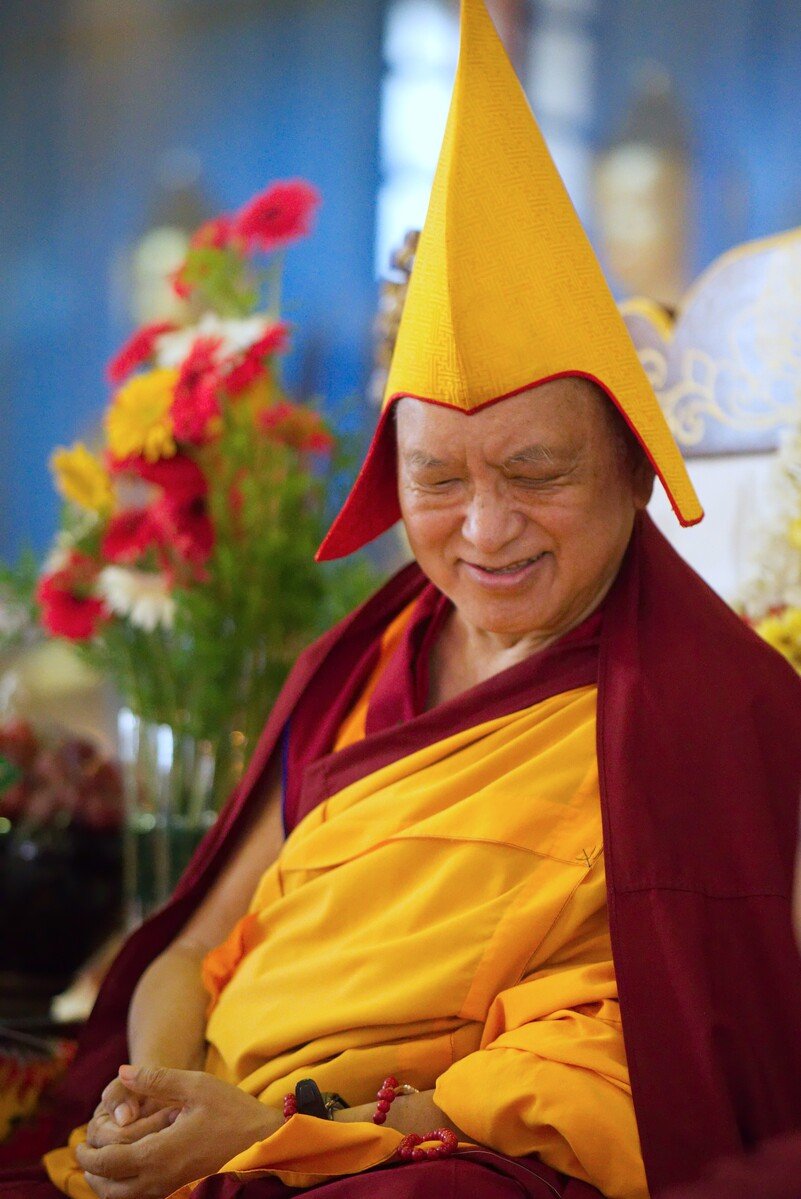
Lama Zopa Rinpoche during a long life puja offered to him at Sera Je Monastery, Byalakuppe, India, November 2017. Photo by Ven. Lobsang Sherab.
Sera Je Monastery is offering a long-life puja for Lama Zopa Rinpoche on October 14 at the Main Prayer Hall in the monastery, and presenting Rinpoche with a special “Gratitude Award” for the many decades of support Rinpoche has shown to the monastery, including the 25+ year accomplishment of the Sera Je Food Fund, which is now a full endowment covering the monastery’s yearly food expenses for over 2,000 Sangha.
All are welcome to join in this auspicious event on Facebook or through an English translation on Zoom (Meeting ID: 837 8829 0095).
We look forward to sharing photos and details from this special puja after the event.
Lama Zopa Rinpoche is the spiritual director of the Foundation for the Preservation of Mahayana Tradition (FPMT), a Tibetan Buddhist organization dedicated to the transmission of the Mahayana Buddhist tradition and values worldwide through teaching, meditation and community service.
11
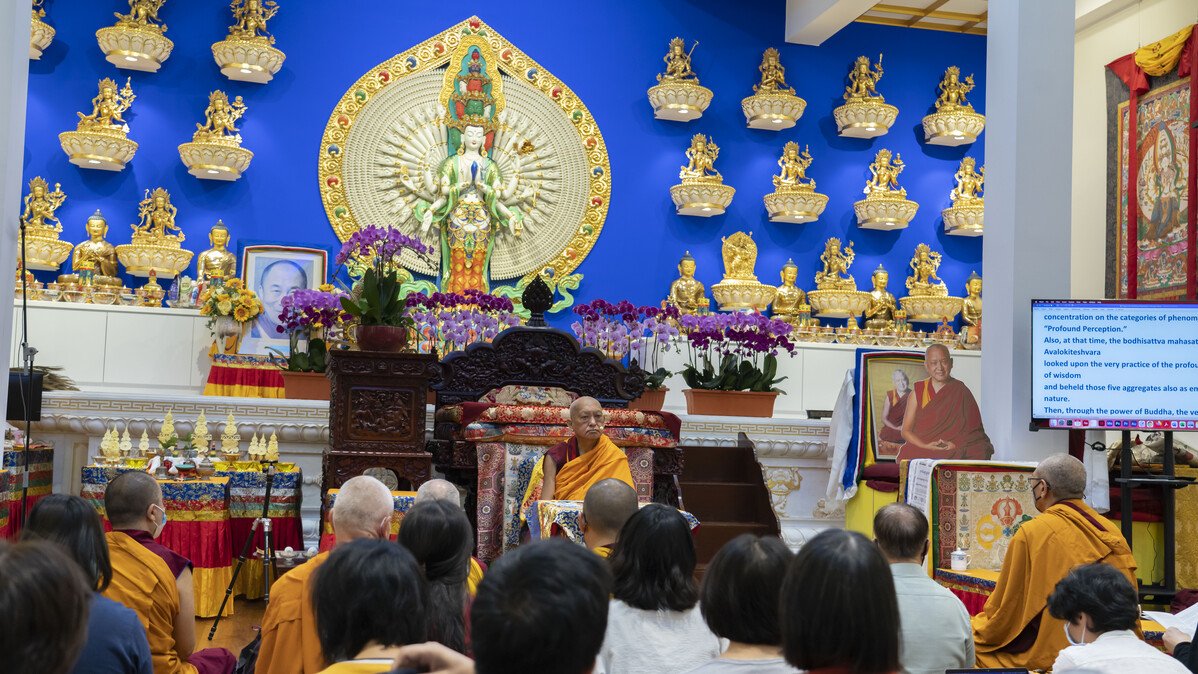
Lama Zopa Rinpoche teaching at Amitabha Buddhist Centre, Singapore, August 2022. Photo by Ven. Lobsang Sherab.
Lama Zopa Rinpoche continued his video teachings on thought transformation from Amitabha Buddhist Centre in Singapore in August and September. Here is a summary of the teaching offered on September 10, 2022:
During Rinpoche’s September 3 teaching (#134 In Your Life as a Couple, Practice Good Heart), Rinpoche offered the oral transmission for Lama Tsongkhapa’s Utilizing Suffering in the Path to Enlightenment. Rinpoche began giving commentary on this important thought transformation text in the September 7 teaching (#135: The Great Difference Between Taking and Not Taking Vows).
In this latest teaching from September 10, Rinpoche continues the commentary on Utilizing Suffering in the Path to Enlightenment starting at 40:06. During this commentary, Rinpoche discusses the benefits of experiencing suffering, including:
- When You Experience Suffering, You Develop Renunciation of Samsara
- When You Experience Suffering, You Develop Trust in the Objects of Refuge
- When You Experience Suffering, It Dispels Arrogance
- When You Experience Suffering, You Become Careful of Negative Karma
- When You Experience Suffering, You Enjoy Virtue
- When You Experience Suffering, You Develop Compassion for Sentient Beings
We invite you to go deeper into the topics presented here, plus many others, by watching Rinpoche’s video below, and reading the full transcript of Rinpoche’s teaching.
Watch Lama Zopa Rinpoche’s teaching “The Benefits of Experiencing Suffering”:
- Read the transcript of Rinpoche’s teaching
- Find Rinpoche’s Teachings on Thought Transformation translated into various languages.
- Dedication verses
Summary of Lama Zopa Rinpoche’s teaching by Carina Rumrill based on the rough transcript by Ven. Joan Nicell with editorial input and additions by Justin Jenkins. This summary is meant to highlight key topics presented by Rinpoche in the recorded video and is not intended to serve as a full representation of Rinpoche’s teaching, which is best received through watching the video and/or reading the full transcript which we will make available once completed.
Watch more from the video series Lama Zopa Rinpoche’s Teachings on Thought Transformation and find links to videos in transcripts, MP3s, additional practice advice, and more:
https://fpmt.org/fpmt/announcements/resources-for-coronavirus-pandemic/advice-from-lama-zopa-rinpoche-for-coronavirus/
You can listen to this teaching on our full-length-teachings podcast as well:
https://fpmt.org/media/podcasts/
Lama Zopa Rinpoche is the spiritual director of the Foundation for the Preservation of Mahayana Tradition (FPMT), a Tibetan Buddhist organization dedicated to the transmission of the Mahayana Buddhist tradition and values worldwide through teaching, meditation and community service.
- Tagged: advice from lama zopa rinpoche, coronavirus, lama zopa rinpoche thought transformation video teaching, video
7
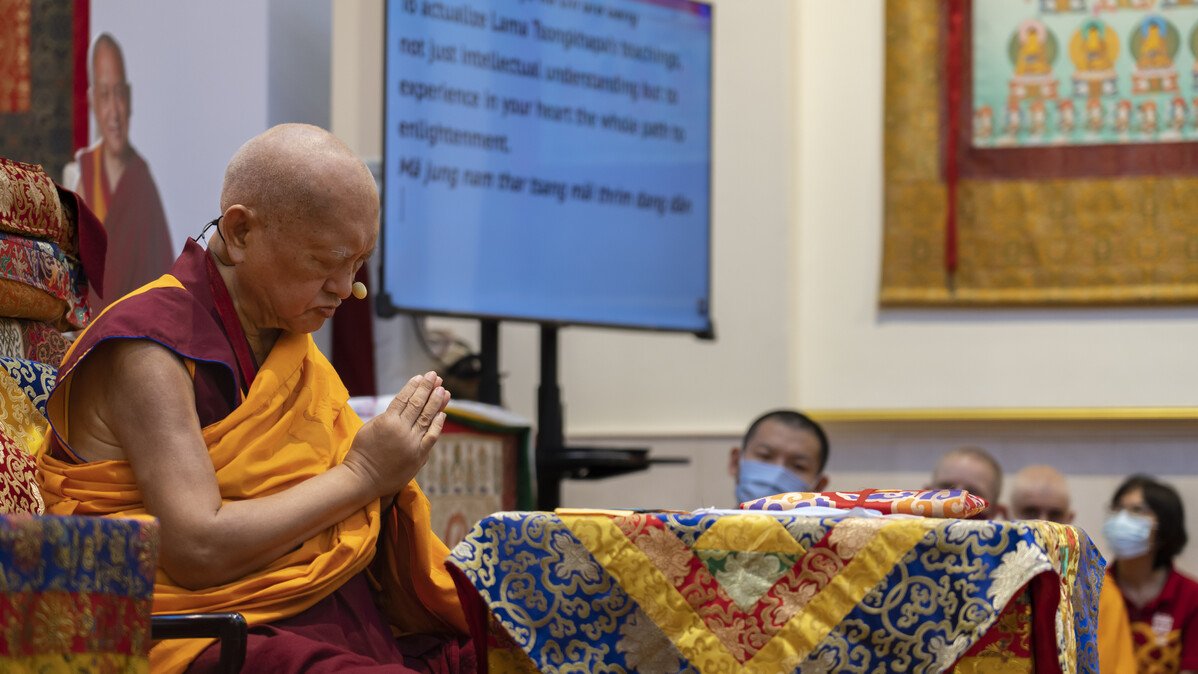
Lama Zopa Rinpoche teaching at Amitabha Buddhist Centre, Singapore, August 2022. Photo by Ven. Lobsang Sherab.
Lama Zopa Rinpoche continued his video teachings on thought transformation from Amitabha Buddhist Centre in Singapore in August and September. Here is a summary of the teaching offered on September 7, 2022:
The most important Dharma, Rinpoche teaches us, is compassion. If you are becoming kinder and more compassionate, this means you are practicing Dharma.
Rinpoche discusses the importance of taking vows. Our virtue is much more extensive after having taken vows than if we have not taken any. This is also true for the non-virtues: it is heavier negative karma for someone ordained to commit a trivial misdeed than for a lay person to indulge in the ten non-virtues. This is why it is so heavy when people who hold bodhisattva vows, and even more so, tantric vows, commit misdeeds. We should take and receive vows to receive a human rebirth again because there is no cause for a higher rebirth other than practicing ethics. We create great merit even by keeping even one precept. By taking vows, one’s virtue increases continuously—even while sleeping, and by not having vows and committing non-virtue, one’s negative karma increases continuously. Because of this, we need to purify our negative karma to stop it from increasing every day.
Rinpoche offers the lung of the Vajrasattva long and short mantras (1:31:17 in the video), to help us with our practice or purification.
Long Vajrasattva Mantra
OṂ VAJRASATVA SAMAYA / MANUPĀLAYA / VAJRASATVA TVENOPATIṢṬHA / DṚḌHO ME BHAVA / SUTOṢYO ME BHAVA / SUPOṢYO ME BHAVA / ANURAKTO ME BHAVA / SARVA SIDDHIM ME PRAYACCHA / SARVA KARMASU CA ME / CITTAṂ ŚRĪYAṂ KURU HŪṂ / HA HA HA HA HOḤ / BHAGAVĀN SARVA TATHĀGATA / VAJRA MĀ ME MUÑCA / VAJRĪ BHAVA / MAHĀ SAMAYASATVA ĀḤ HŪṂ PHAṬ
Short Vajrasattva Mantra
OṂ VAJRASATVA HŪṂ
During Rinpoche’s September 3 teaching (#134 In Your Life as a Couple, Practice Good Heart), Rinpoche offered the lung for Lama Tsongkhapa’s Utilizing Suffering in the Path to Enlightenment. In this video, Rinpoche began translating and offering commentary on this important thought transformation teaching by Lama Tsongkhapa at 1:40:14.
We invite you to go deeper into the topics presented here, plus many others, by watching Rinpoche’s video below and reading the full transcript of Rinpoche’s teaching.
Watch Lama Zopa Rinpoche’s teaching “The Great Difference Between Taking and Not Taking Vows”:
- Read the transcript of Rinpoche’s teaching.
- Find links to resources to support your Vajrasattva practice in the Foundation Store.
- Find Rinpoche’s Teachings on Thought Transformation translated into various languages.
- Dedication verses
Summary of Lama Zopa Rinpoche’s teaching by Carina Rumrill based on the rough transcript by Ven. Joan Nicell with editorial input and additions by Justin Jenkins. This summary is meant to highlight key topics presented by Rinpoche in the recorded video and is not intended to serve as a full representation of Rinpoche’s teaching, which is best received through watching the video and/or reading the full transcript which we will make available once completed.
Watch more from the video series Lama Zopa Rinpoche’s Teachings on Thought Transformation and find links to videos in transcripts, MP3s, additional practice advice, and more:
https://fpmt.org/fpmt/announcements/resources-for-coronavirus-pandemic/advice-from-lama-zopa-rinpoche-for-coronavirus/
You can listen to this teaching on our full-length-teachings podcast as well:
https://fpmt.org/media/podcasts/
Lama Zopa Rinpoche is the spiritual director of the Foundation for the Preservation of Mahayana Tradition (FPMT), a Tibetan Buddhist organization dedicated to the transmission of the Mahayana Buddhist tradition and values worldwide through teaching, meditation and community service.
- Tagged: advice from lama zopa rinpoche, coronavirus, lama tsongkhapa, lama zopa rinpoche thought transformation video teaching, vajrasattva, video
5
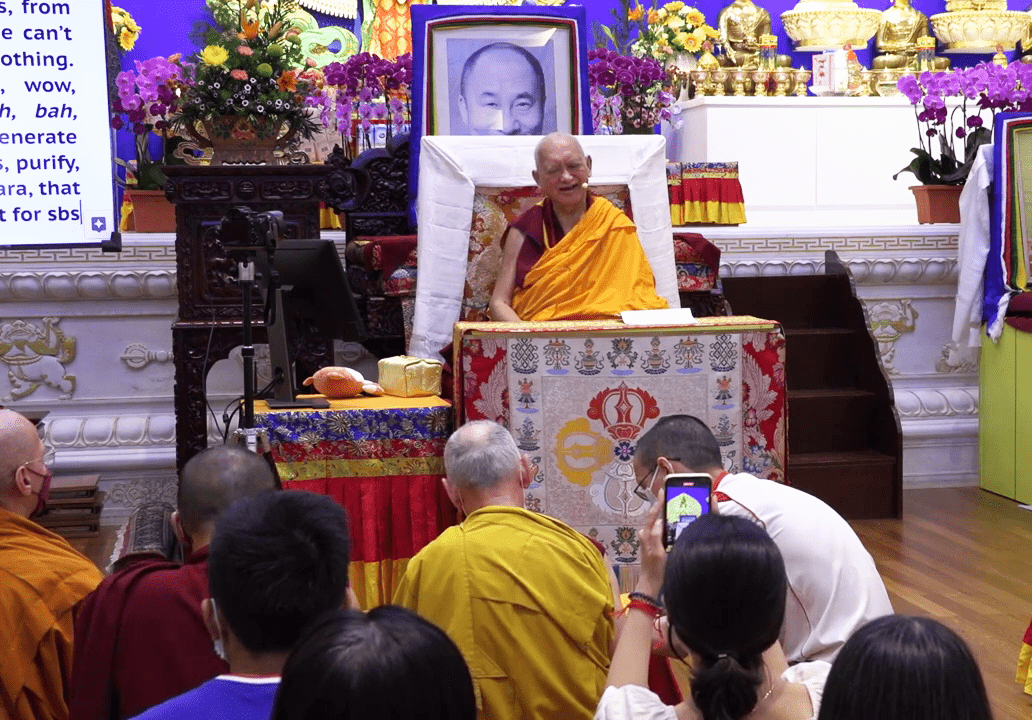
Lama Zopa Rinpoche giving thought transformation teachings at Amitabha Buddhist Centre, Singapore, September 3, 2022.
Lama Zopa Rinpoche continued his video teachings on thought transformation from Amitabha Buddhist Centre in Singapore in August and September. Here is a summary of the teaching offered on September 3, 2022:
For those of us living as a couple in relationships, we need to practice having a good heart. With body, speech, and mind, we have incredible opportunities to collect good karma. If we dedicate our own lives to serving others, to create happiness and reduce suffering in others, then we influence our companions to gradually do the same. This is really offering so much help to them, helping them to be free from samsara and attain enlightenment more quickly. Even if not thinking about enlightenment, even if not Buddhist, it is still very logical to practice a good heart because it brings so much happiness to others.
Rinpoche offers the oral transmission of Lama Tsongkhapa’s thought transformation teaching, Utilizing Suffering in the Path to Enlightenment at 1:13:44 in the video.
At the end of this teaching, Rinpoche also shared some advice offered to a geshe in Singapore who contracted Covid-19. Rinpoche requested that copies of this advice be made available so that those who receive it will, “enjoy the most and be most happy.” This full advice is available to all.
We invite you to go deeper into the topics presented here, plus many others, by watching Rinpoche’s video below and reading the full transcript of Rinpoche’s teaching.
Watch Lama Zopa Rinpoche’s teaching “In Your Life as a Couple, Practice Good Heart”:
- Read the transcript of Rinpoche’s teaching.
- Find Rinpoche’s Teachings on Thought Transformation translated into various languages.
- Dedication verses
Summary of Lama Zopa Rinpoche’s teaching by Carina Rumrill based on the rough transcript by Ven. Joan Nicell with editorial input and additions by Justin Jenkins. This summary is meant to highlight key topics presented by Rinpoche in the recorded video and is not intended to serve as a full representation of Rinpoche’s teaching, which is best received through watching the video and/or reading the full transcript which we will make available once completed.
Watch more from the video series Lama Zopa Rinpoche’s Teachings on Thought Transformation and find links to videos in transcripts, MP3s, additional practice advice, and more:
https://fpmt.org/fpmt/announcements/resources-for-coronavirus-pandemic/advice-from-lama-zopa-rinpoche-for-coronavirus/
You can listen to this teaching on our full-length-teachings podcast as well:
https://fpmt.org/media/podcasts/
Lama Zopa Rinpoche is the spiritual director of the Foundation for the Preservation of Mahayana Tradition (FPMT), a Tibetan Buddhist organization dedicated to the transmission of the Mahayana Buddhist tradition and values worldwide through teaching, meditation and community service.
- Tagged: advice from lama zopa rinpoche, coronavirus, lama zopa rinpoche thought transformation video teaching, video
4
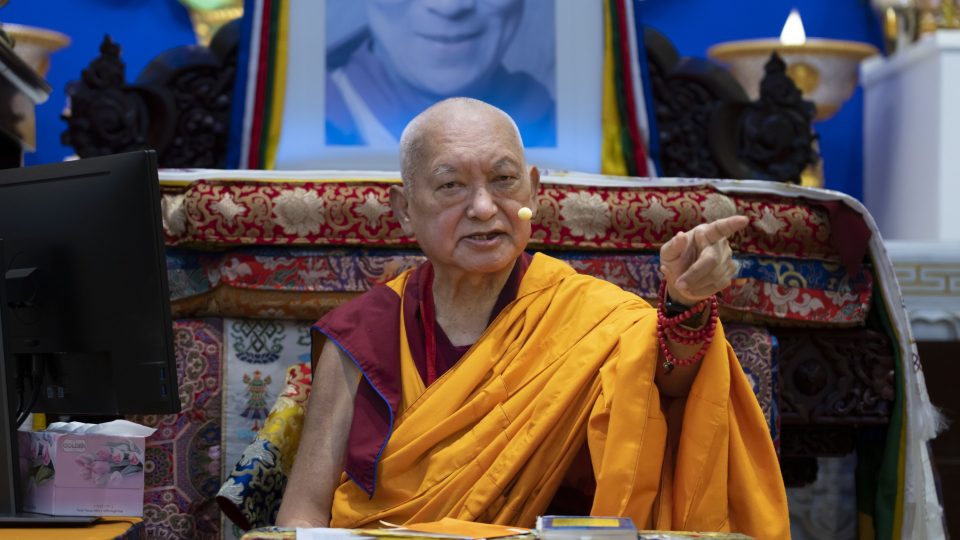
Lama Zopa Rinpoche teaching at Amitabha Buddhist Centre, Singapore, August 2022. Photo by Ven. Lobsang Sherab.
Since the early days of the COVID pandemic, Lama Zopa Rinpoche has been offering teachings on thought transformation (lojong). In these teachings, Rinpoche has been urging us to use these difficult times, and any obstacles in life, on the path to enlightenment.
Recently, Rinpoche offered some advice to a geshe in Singapore who contracted COVID. Rinpoche shared this advice during his September 3, 2022 thought transformation teaching from Amitabha Buddhist Centre and requested that copies of this advice be made available so that those who receive it will, “enjoy the most and be most happy.” We will share a summary and video of this entire teaching in tomorrow’s blog.
While this advice was given to an advanced practitioner, in it we will all find inspiration for turning problems into opportunities to practice and rejoice.
My dear One,
So I heard this morning that you got COVID. You should think, “Woooow! I found a wish-granting jewel.” Diamonds and gold, are nothing, even skies of gold and diamonds, are not as precious. You getting COVID is more precious than skies of wish-granting jewels which don’t stop rebirth in the lower realms, don’t stop rebirth in samsara, cannot free you from samsara, cannot free you from lower nirvana, cannot bring you to enlightenment. So it is nothing.
But COVID destroys the self-cherishing thought making it possible to generate bodhicitta, then become free from samsara, free from the lower realms, and that is main cause to achieve enlightenment for sentient beings then liberate the numberless sentient beings from lower realms, from samsara, from lower nirvana. You bring all the sentient beings to enlightenment. It is unbelievable what COVID does for you, unbelievable benefit. You You should feel unbelievable, great happiness to have COVID.
Why? Because you can experience all sentient beings’ COVID now. You can experience and dedicate it. You can experience all the sentient beings’—numberless human beings, numberless hungry ghosts, numberless animals, numberless human beings, numberless suras, numberless asuras in different universes—you can experience all the numberless sentient beings’ COVID. You can experience and dedicate all the sentient beings’ COVID, all the suffering and causes, the negative karma and defilements, then let the sentient beings achieve enlightenment.
Choje Gotsangpa, a great Kagyu lama, advised:
“By me experiencing this, may sentient beings be free from all the sufferings, all the sicknesses, all causes, negative karma, due to that may sentient beings become enlightened.”
You can recite this as mantra like OṂ MAṆI PADME HŪṂ. You can recite this prayer, so incredibly precious. Because of this, then you can take all the sentient beings’ COVID, so, so precious. All the sufferings came from self-cherishing thought, given to you by self-cherishing thought. Self-cherishing thought caused you to suffer from beginningless rebirths.
Not only in the past, not only in the present, the self-cherishing thought continuously harms you in the future as long as you follow it. Not just harm for yourself, the numberless hell beings, hungry ghosts, animals, human beings, suras, asuras–you have been harming numberless sentient beings, with the self-cherishing thought! They have had to suffer from beginningless rebirths up to now. So much suffering. Then again in the future, due to the self-cherishing thought. So therefore, the self-cherishing thought is the main enemy, the main worst enemy in the world, in the life, not only for you, it is most harmful to numberless sentient beings, already harmed from beginningless rebirths now and in the future. So now this is the worst enemy.
So COVID is so important. It is given to you by the self-cherishing thought, now you give back. You experience all the sentient beings’ COVID, you give it back to the self-cherishing thought and the self-cherishing thought is eliminated. Every time, every time the self-cherishing thought is destroyed, eliminated, then with that then your root of your samsara, oceans of sufferings, ignorance, holding the I as real, I that appeared real and truly existing, then mind holding onto that, looking at that as real and true. The aggregates appear real from there, then holding that as true. That is ignorance. So all that is eliminated. Eliminated because the I, real I appearing there, is not there at all. What appeared from there is not there at all, so you see, totally empty. So stay there a little while, then you do giving. Ok, but mostly you spend time taking. That is great, great.
Then it makes you to do tonglen. Each time you take sentient beings’ suffering, each time you give away your body, possessions, and merits to numberless sentient beings, then you become closer to enlightenment, you collect more than skies of merits each time and you become closer and closer to enlightenment.
You are so lucky, so fortunate to get COVID, you should think that way, so rejoice. It is so good. “Oh, I got COVID!” Rejoice. Even if you die, by experiencing COVID for sentient beings, experiencing COVID with bodhicitta, then you don’t go to lower realms.
Actually bodhisattvas prefer to be reborn in the lower realms, in the hell, for the sake of even one sentient being, to liberate them from samsara, from the lower realms; they pray to be born in hell for even one sentient being, to liberate them from there. That is their great wish, stronger than even the arhats, who like the blissful state of peace for oneself. You understand?
So you see by experiencing for sentient beings, that is the power of a good heart. Then you never get reborn in the lower realms. Like the Kadampa geshe, Chekawa, always prayed to be born in the lower realms, but the day he was going to die, the appearance of pure land happened right away, around him, so he told his attendant he didn’t succeed, so now make offerings. So understand, you are so lucky, you should rejoice.
Thank you very much. I’m giving an example but like that you should do similar with all the obstacles. Like that. Thank you very much.
With much love and prayers,
Lama Zopa
Transcribed by Ven. Joan Nicell at Amitabha Buddhist Centre, Singapore, September 2, 2022. Lightly edited by Ven. Holly Ansett and further edited for publication by Carina Rumrill.
Lama Zopa Rinpoche is the spiritual director of the Foundation for the Preservation of Mahayana Tradition (FPMT), a Tibetan Buddhist organization dedicated to the transmission of the Mahayana Buddhist tradition and values worldwide through teaching, meditation, and community service.
Explore Lama Zopa Rinpoche’s teaching series on thought transformation and find links to videos in transcripts, MP3s, additional practice advice, and more:
https://fpmt.org/fpmt/announcements/resources-for-coronavirus-pandemic/advice-from-lama-zopa-rinpoche-for-coronavirus/
28
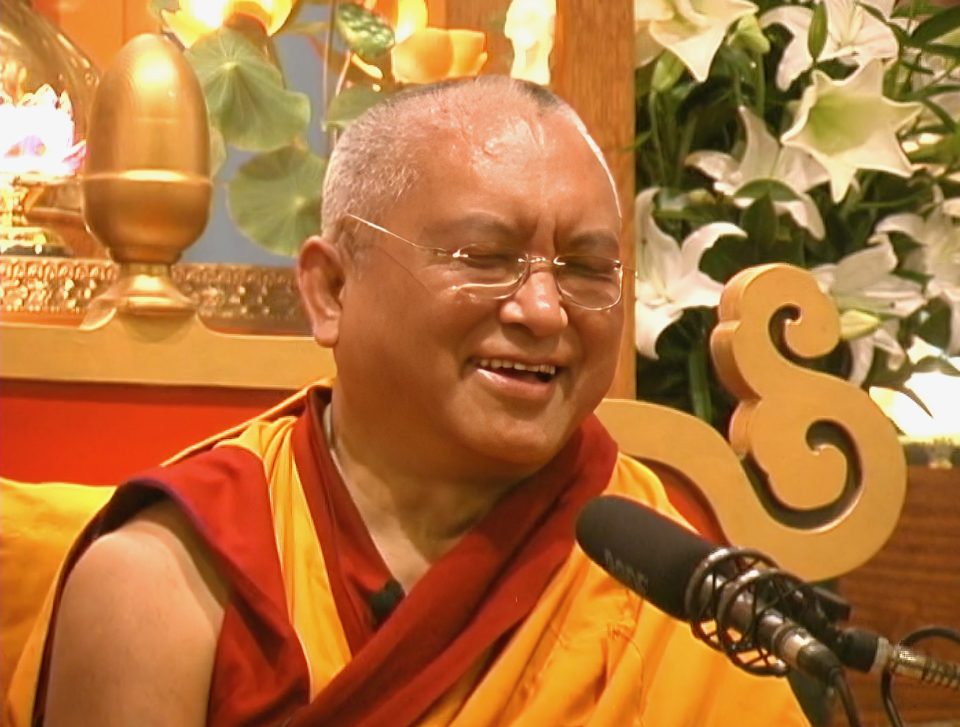
Lama Zopa Rinpoche teaching at Tara Institute, AUS, June 2, 2006.
In 2006, Lama Zopa Rinpoche offered a teaching at Tara Institute, AUS. We are pleased to offer this teaching in four parts, which has just been added to the FPMT website and the FPMT YouTube channel.
In the first video Rinpoche touched on topics such as emptiness according to the Svatantrika view, the unification of emptiness and dependent arising, and searching for the real I. He recounted the history of how Lama Atisha came to Tibet and how to integrate the three levels of teachings.
In the second video Rinpoche spoke on the importance of bodhicitta when following the Vajrayana, recounted the story of Dromtönpa realizing bodhicitta while serving Atisha, eliminating the root ignorance and achieving nirvana, and then explained how to use the verse “Like a star …” to meditate on emptiness and impermanence in daily life. He closed by returning to the subject of emptiness, analyzing how the I, aggregates such as form, head, atom or consciousness exist, as well as looking at the concept of true existence.
In the third video Rinpoche continued his analysis on how the I, aggregates such as form, head, atom or consciousness exist to illustrate the emptiness of the aggregates. He continues his elaboration on using the verse, “Like a star …” to deepen our understanding of emptiness and emphasizes to apply this in daily life and relationships. Answering the question of a student, Rinpoche then taught on the importance of guru devotion and bodhicitta, how to serve the guru, and the purpose of guru devotion.
In the fourth video, Rinpoche finished his explanation on the purpose of guru devotion and then extensively dedicated the merits of giving these teachings.
All of these videos as well as downloadable MP3 audio are available on the Rinpoche Available Now page.
21
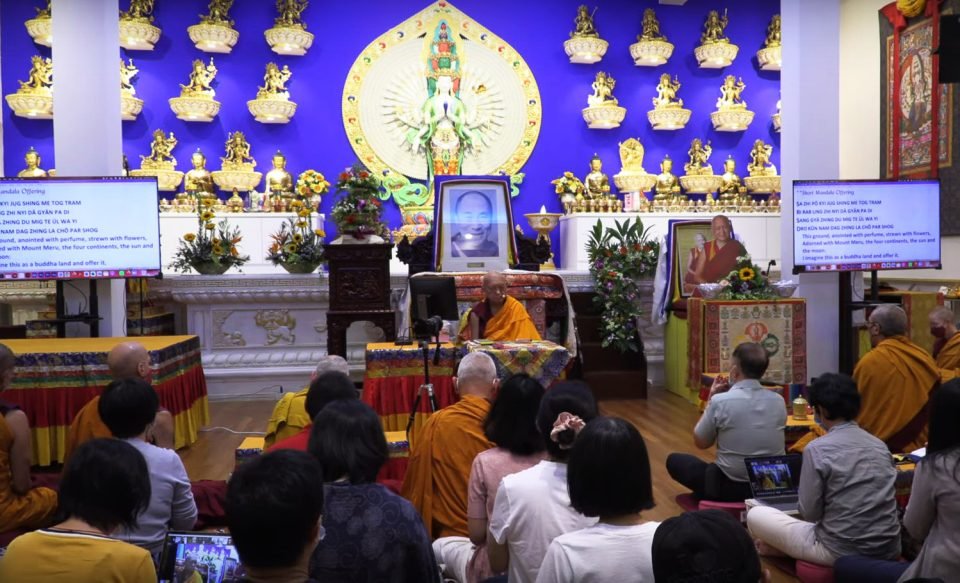
Lama Zopa Rinpoche offering thought transformation teachings at Amitabha Buddhist Centre, Singapore, August 16, 2022.
Lama Zopa Rinpoche continued his video teachings on thought transformation from Amitabha Buddhist Centre in Singapore in August. Here is a summary of the teaching offered on August 16, 2022:
Rinpoche offers some of the history of how he began teaching courses at Kopan Monastery in Nepal and how the FPMT organization began (starting at 28:12 in the video).
Real happiness comes from a good heart, Rinpoche reminds us, not come from the outside. Using the example of Milarepa, who externally had nothing but had incredible realizations and inner peace and happiness, we can see that happiness comes from the mind, not from what we have. Believing that happiness comes from outside, including how much wealth we accumulate, causes great suffering and dissatisfaction, as well as so much worry and fear.
For those of us living as lay couples, Rinpoche advises that we practice the ten virtues together and Rinpoche also suggests practicing the ten Dharma conducts.
We invite you to go deeper into the topics presented here, plus many others, by watching Rinpoche’s video below and reading the full transcript of Rinpoche’s teaching.
Watch Lama Zopa Rinpoche’s teaching “How to Make Your Life Happy”:
- Read the transcript of Rinpoche’s teaching.
- Find Rinpoche’s Teachings on Thought Transformation translated into various languages.
- Dedication verses
Summary of Lama Zopa Rinpoche’s teaching by Carina Rumrill based on the transcript by Ven. Joan Nicell with editorial input and additions by Justin Jenkins. This summary is meant to highlight key topics presented by Rinpoche in the recorded video and is not intended to serve as a full representation of Rinpoche’s teaching, which is best received through watching the video and/or reading the full transcript.
Watch more from the video series Lama Zopa Rinpoche’s Teachings on Thought Transformation and find links to videos in transcripts, MP3s, additional practice advice, and more:
https://fpmt.org/fpmt/announcements/resources-for-coronavirus-pandemic/advice-from-lama-zopa-rinpoche-for-coronavirus/
You can listen to this teaching on our full-length-teachings podcast as well:
https://fpmt.org/media/podcasts/
Lama Zopa Rinpoche is the spiritual director of the Foundation for the Preservation of Mahayana Tradition (FPMT), a Tibetan Buddhist organization dedicated to the transmission of the Mahayana Buddhist tradition and values worldwide through teaching, meditation and community service.
- Tagged: advice from lama zopa rinpoche, coronavirus, lama zopa rinpoche thought transformation video teaching, video
13
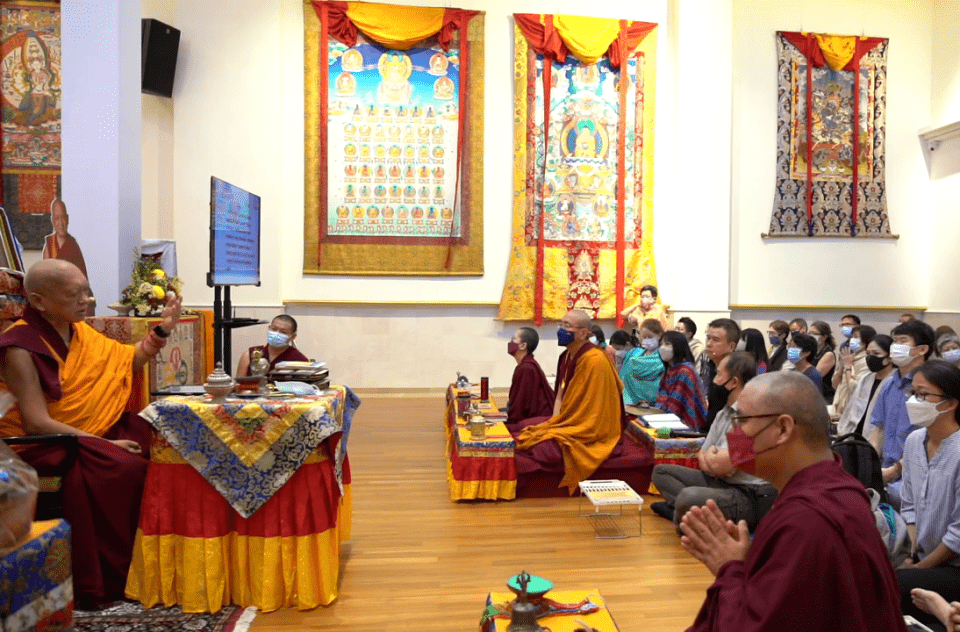
Lama Zopa Rinpoche teaching on the Chokhor Duchen Buddha Day at Amitabha Buddhist Centre, August 1, 2022.
Lama Zopa Rinpoche offered this video teaching during a Lama Chopa puja on Chokhor Duchen, or “Wheel-Turning Day”, August 1, 2022 at Amitabha Buddhist Centre in Singapore. Chokhor Duchen commemorates when Shakyamuni Buddha gave the first teaching after his enlightenment at Deer Park, Sarnath, India. Here is a summary of Rinpoche’s teaching below:
While thanking Amitabha Buddhist Centre members for visiting elderly homes and offering care to the residents, Rinpoche offered some valuable advice about how to be of most benefit when helping the elderly and those facing death (starting at 19:00 in the video and page 4 of the transcript). In this advice Rinpoche mentions several mantras that are particularly beneficial for this purpose.
Rinpoche also discusses the kindness of the Buddha, to commemorate the special Buddha Day of Chokhor Duchen.
Some people don’t think much about the kindness of the Buddha, Rinpoche explains. But without the Buddha, there wouldn’t be teachings, you wouldn’t meet the Dharma in this world. This alone is due to the limitless skies of kindness of the Buddha. The Buddha, with bodhicitta, renounced his own self-cherishing thought and became enlightened. We have not given this up and have followed it from beginningless rebirths, suffering in samsara up to now. With bodhicitta, the Buddha cares for us and loves us a hundred thousand times more than how much we love ourselves. We think we love ourselves but this is nothing compared to how much the Buddha loves and cares for us. Realizing the Buddha’s kindness inspires us
Even a small benefit to sentient beings is an offering to the Buddha because it satisfies and pleases the holy mind. This is an offering to numberless buddhas and bodhisattvas. Likewise, harming any sentient being harms the Buddha because sentient beings are what the Buddha cherishes most. For three countless great eons, the Buddha worked on the path and achieved enlightenment for them, for every insect and every person. If we harm them, we harm numberless buddhas and bodhisattvas. Even offering a kind word or a smile to someone who is worried or afraid can bring so much relief. This is the best offering to numberless buddhas and bodhisattvas.
What pleases the buddhas and bodhisattvas most is not just making extensive, large, beautiful offerings filling the whole city or the sky. It is having compassion for sentient beings. Every sentient being wants happiness and doesn’t want suffering. When we let go of I and cherish others; that is the best offering, the best way to repay the kindness of the Buddha.
We invite you to go deeper into the topics presented here, plus many others, by watching Rinpoche’s video, below.
Watch Lama Zopa Rinpoche’s teaching “The Kindness of the Buddha is Limitless Like the Sky”:
This summary of Lama Zopa Rinpoche’s teaching is by Carina Rumrill, based on the live transcript by Ven. Joan Nicell with additions from Ven. Tenzin Tsomo, with editorial input and additions by Justin Jenkins. This summary is meant to highlight key topics presented by Rinpoche in the recorded video and is not intended to serve as a full representation of Rinpoche’s teaching, which is best received through watching the video and/or reading the full transcript.
Lama Zopa Rinpoche is the spiritual director of the Foundation for the Preservation of Mahayana Tradition (FPMT), a Tibetan Buddhist organization dedicated to the transmission of the Mahayana Buddhist tradition and values worldwide through teaching, meditation and community service.
- Tagged: advice from lama zopa rinpoche, video
- Home
- News/Media
- Study & Practice
- About FPMT Education Services
- Latest News
- Programs
- New to Buddhism?
- Buddhist Mind Science: Activating Your Potential
- Heart Advice for Death and Dying
- Discovering Buddhism
- Living in the Path
- Exploring Buddhism
- FPMT Basic Program
- FPMT Masters Program
- FPMT In-Depth Meditation Training
- Maitripa College
- Lotsawa Rinchen Zangpo Translator Program
- Universal Education for Compassion & Wisdom
- Online Learning Center
- Prayers & Practice Materials
- Overview of Prayers & Practices
- Full Catalogue of Prayers & Practice Materials
- Explore Popular Topics
- Benefiting Animals
- Chenrezig Resources
- Death & Dying Resources
- Lama Chopa (Guru Puja)
- Lama Zopa Rinpoche: Compendium of Precious Instructions
- Lama Zopa Rinpoche: Life Practice Advice
- Lama Zopa Rinpoche Practice Series
- Lamrim Resources
- Mantras
- Prayer Book Updates
- Purification Practices
- Sutras
- Thought Transformation (Lojong)
- Audio Materials
- Dharma Dates – Tibetan Calendar
- Translation Services
- Publishing Services
- Teachings and Advice
- Find Teachings and Advice
- Lama Zopa Rinpoche Advice Page
- Lama Zopa Rinpoche: Compendium of Precious Instructions
- Lama Zopa Rinpoche Video Teachings
- ༧སྐྱབས་རྗེ་བཟོད་པ་རིན་པོ་ཆེ་མཆོག་ནས་སྩལ་བའི་བཀའ་སློབ་བརྙན་འཕྲིན།
- Podcasts
- Lama Yeshe Wisdom Archive
- Buddhism FAQ
- Dharma for Young People
- Resources on Holy Objects
- Ways to Offer Support
- Centers
- Affiliates Area
- Teachers
- Projects
- Charitable Projects
- Make a Donation
- Applying for Grants
- News about Projects
- Other Projects within FPMT
- Support International Office
- Projects Photo Galleries
- Give Where Most Needed
- FPMT
- Shop
Translate*
*powered by Google TranslateTranslation of pages on fpmt.org is performed by Google Translate, a third party service which FPMT has no control over. The service provides automated computer translations that are only an approximation of the websites' original content. The translations should not be considered exact and only used as a rough guide.Whether one believes in a religion or not, and whether one believes in rebirth or not, there isn’t anyone who doesn’t appreciate kindness and compassion.







